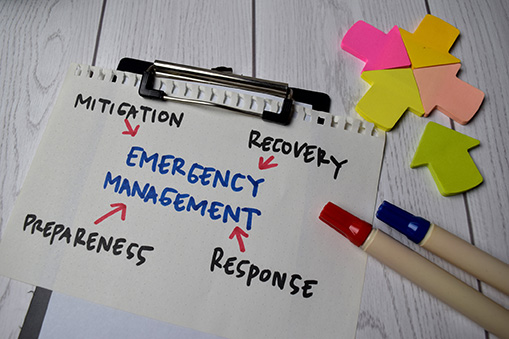Crucial role of ports in Humanitarian Logistics
… ignorance will only lead to further devastation and loss of life
By Curtis Dennie *
2018, November 1: In 2017, hurricanes Irma and Maria devastated several countries in the Caribbean and exposed the structural deficiencies of the logistics architecture of the region. The economic impact was catastrophic with a total estimated cost of USD92 billion.
Since 1970, the Caribbean region has been exposed to over 475 storms (hurricanes?). The probability of a hurricane strike is greater than 10% per year.
In global transportation systems, ports serve as integrated logistics centres but also as the main link between human relief organizations and affected peoples. Ports are also among the key national assets with the capability to deliver a strong response during the aftermath of natural disasters such as hurricanes. However, there is often a disconnection between the role of ports as a strategic component of the disaster management mechanism and the disaster management framework.
The disaster management framework (DMF) consists of risk mitigation and preparedness; response and recovery. The key factor that underpins the DMF is logistics. The experiences of Dominica, Barbuda, St. Croix, St. Maarten, Tortola, and Puerto Rico highlighted the significant role of logistics.
Limitations in the logistics capacity of a country can impede the response from relief organizations. Logistics play an important role in providing a bridge between disaster preparedness and response; between procurement and distribution; and, between headquarters and the field.
The effectiveness and speed of response for major humanitarian programmes, such as health, food, clothing, shelter, water and sanitation depend on the quality of infrastructure that are in place. The reality is that disaster response agencies are in fact logistical organizations. While the level of preparedness and planning may vary, depending on the nature and speed at which a disaster or emergency occurs, the logistical challenges are always complex and daunting. It is in this context that the role of ports in humanitarian logistics is examined.
Humanitarian logistics is designed to alleviate the suffering of the affected population, especially in the aftermath of the acute or permanent disasters and crises.[i] It is primarily concerned with bringing the products of humanitarian aid, to the most affected, quickly, in good quality, in amounts as needed, and at minimum costs (with regard to efficiency). [ii]
There exists a knowledge gap on the role of seaports in humanitarian logistics in the Caribbean. Seaports have been described as socio-economic spaces that have a multifaceted impact on the environment.[iii] Ports are critical infrastructure that facilitate resource mobilization, staging platforms, docking, warehousing and distribution, providing technical expertise and managing out-bound/ in-bound logistics
Urgency
The vulnerabilities of the Caribbean region to natural disasters should create a compelling sense of urgency to establish a prominent role of ports in the logistics architecture.

Ports facilitate various sizes of ships. This enables a country to provide the level of agility that is required. Ports are designed as staging platforms that can facilitate mass evacuations. Ports provide security, reliability, safety, efficiency and predictability for the transportation of supplies. Ports can guarantee the sustainability of a population, provide reliable connectivity and facilitate the efficient planning and distribution of supplies. Disaster planning must therefore incorporate the role of port and the logistics of handling and distribution of relief supplies.
The advent of containerization presented many opportunities for logistics management. Containers offer mobility, storage, security and ease of distribution of large quantities of supplies. Ports facilitate the un-stuffing of containers as well as the sorting and distribution of supplies. Ports also have capabilities to position its assets to support relief distribution, reposition small ships to safety and to provide other support to state and non-state actors.
Globalisation and the rapid increase in world trade over the past decade have contributed to greater demand for international transport and logistics and, consequently, the expansion of the maritime industry’s significant role in the global development of human society, impacting the military, economic, political, religious and cultural sectors. The capabilities of logistics were fully utilized by Alexander the Great, the first military leader to understand logistics and to use it efficiently in military campaigns. The Greeks created a revolution in the construction of ships. This increased their transportation capabilities in the movement of military supplies and facilitated intercontinental trade.
It is these capabilities that enable disaster management strategies to be successful, since ports facilitate a vital component of sea and landside logistics. Ports serve as a reservoir of technical skill sets and specialist knowledge that are limited in the general population.
The impact of a disaster may inhibit the mobilization of regular staff at the port. This vulnerability can be mitigated by training members of the national forces who can then be mobilized. Efficiencies in port logistics will save lives and result in reduction in time, costs, vulnerabilities, national security risks, exposure to health hazards, fear, and uncertainties in the population. However, the national logistics architecture must exist prior to the impact of storms.
There is an urgent requirement to conduct a comprehensive review of the national disaster plans in the region. And an analysis of the plans should include the conducting of a logistical audit.
A logistical audit is a thorough review of capabilities of a country which includes (but not limited to) its seaport, airport, medical infrastructure, national disaster agency, transportation, public heavy-duty equipment, water and electrical facilities.
Bureaucracies in the decision-making process remain a challenge in disaster management and serve as a constraint to national and regional agility. Agility must be at the heart of humanitarian logistics. The complexity of disaster situations, operational challenges, the different stakeholders involved and the collaboration between them present major challenges for humanitarian logistics. A critical question is: how can we develop agility from complexity?
Agility is acquired through infrastructure development; training and development; planning, innovation; resource allocation; and, mobilization, quick decision-making, collaboration and by establishing strategic alliances.
Important
 An evaluation of the level of collaboration between the public and private sector is an important function in pre-disaster planning. The purpose of this assement is to determine the quality of communication and technology that exists, suppliers’ relationships and national inventory planning for supplies post-storm due to our vulnerability to food security and communication.
An evaluation of the level of collaboration between the public and private sector is an important function in pre-disaster planning. The purpose of this assement is to determine the quality of communication and technology that exists, suppliers’ relationships and national inventory planning for supplies post-storm due to our vulnerability to food security and communication.
Disasters are disruptive forces in the supply chain, thus the linkage between importers, banks, suppliers, carriers and the ports is fundamental to disaster planning. Plans must incorporate regional and international intervention which may require commercial and military support (sea and air).
The logistical support of military forces will significantly improve our agility. Therefore, the region must identify countries for the pre-staging of regional and international armed forces. Ports can provide critical logistical support for the prestaging of military supplies and interventions.
Policy makers and practitioners should plan for post-disaster seaport damage and congestion since 90% of imports are transported via ocean. Therefore, in view of this, alternative landing spaces (sea and air) should be identified to facilitate seamless logistics.
A key path for the response stage of disaster management is the operationalization of ports. Ports must be functional because the handling of in-bound supplies from donor agencies can be chaotic and requires effective logistics coordination and consolidation. Ports are the main distributaries of the supply chain and, as such, inefficiencies along the chain have implications for the response and recovery stages. The extent of the recovery of the national economy is dependent on the port’s operations.
Ports play a vital role in post-disaster development by the facilitation of international trade; the collection of government revenue; the distribution of supplies; the rebuilding of infrastructure; and, the mobilization of financial services and the tourism sector. Ports are therefore a key driver of the economic activities in a country. This underpins the role of ports in economic development.
In an effort to build resiliency, consideration should be given for the facilitation of several national training workshops (on disaster logistics) for key state and non-state actors. In this regard, a regional conference on disaster logistics should be convened.
Given our vulnerabilities and the socio-economic implications, policy-makers and disaster management practitioners in the region should give urgent attention to the role of ports in logistics management. The failure to incorporate seaports in disaster management creates further complexities, which can lead to disastrous consequences.
Policy makers must pay careful attention to the quality of infrastructure and capabilities that exist at their seaports. Capabilities related to equipment, storage, wharves, berthing spaces, tugs, barges and pilot boats, are all important factors in disaster planning and execution.
Ignoring these imperatives can only lead to further devastation and loss of life in a hurricane-prone region such as the Caribbean. []
[i] Abushaikhaa, & Schumann-Bölscheb Humanitarian Technology: Science, Systems and Global Impact 2016, HumTech2016, 7-9 June 2016,
[ii] Ibid
[iii] Montwill (2014) The role of seaports as logistics centers in the modelling of the sustainable system for distribution of goods in urban areas Andrzej
* Curtis Dennie is Port Operations Manager at the Antigua & Barbuda Port Authority Deep Water Harbour. Contact: cdennie@ymail.com.






